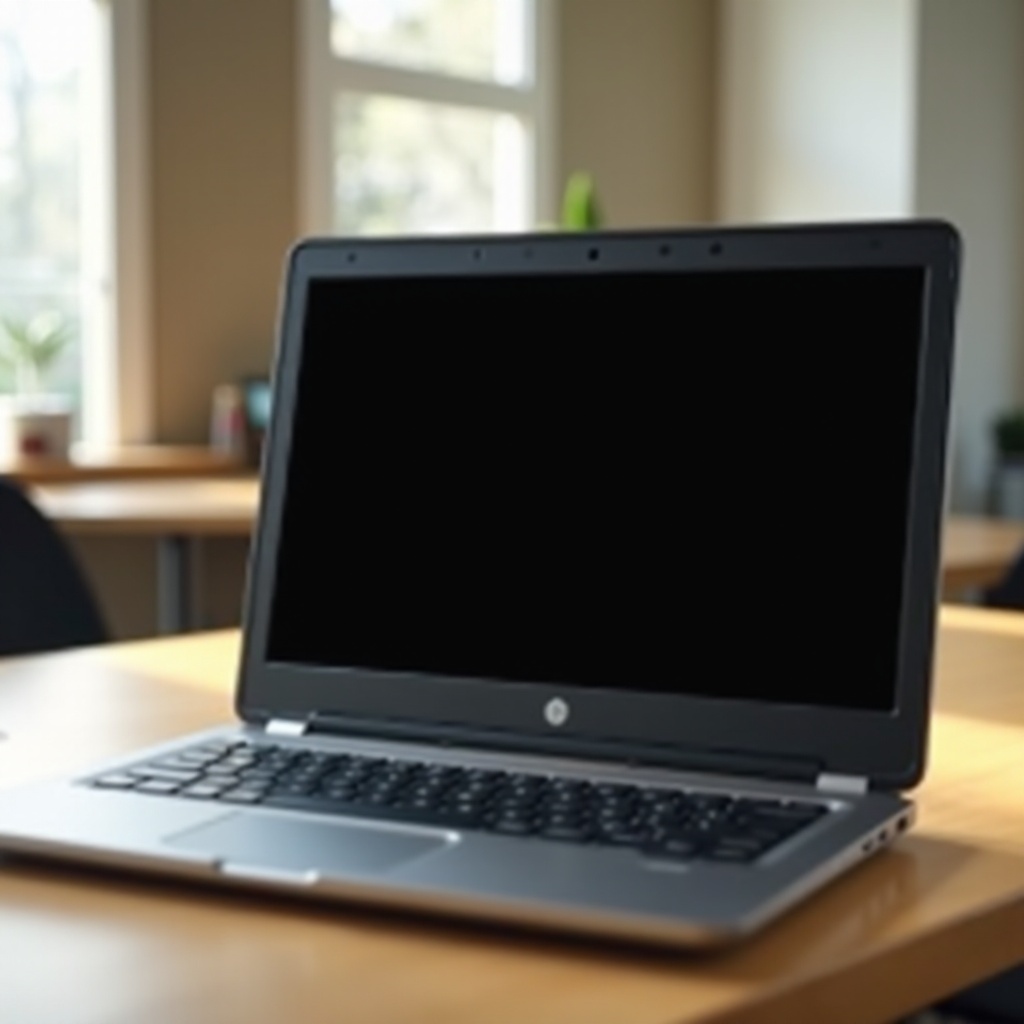Introduction
Facing a situation where your HP laptop powers on but the screen remains black can be frustrating. This guide will walk you through common causes and practical solutions to get your laptop back to working condition.

Common Reasons for Black Screens on HP Laptops
When your HP laptop turns on but the screen is black, several factors might be responsible. Understanding these reasons can help in pinpointing the exact issue.
Hardware Issues
Hardware problems are frequent culprits behind black screens. You might have a loose connection inside the laptop, a defective screen, or issues with the internal components such as the motherboard.
Software Conflicts
Software conflicts or corrupted system files can cause the screen to remain black when the laptop turns on. Recent updates or changes to the operating system might trigger these problems.
Driver Problems
Out-of-date or corrupted display drivers can lead to screen issues. Ensuring your drivers are up-to-date is critical for the smooth functioning of the display.
Faulty Power Supply
An insufficient or faulty power supply can also result in a black screen. Your laptop might turn on with limited power, failing to activate the display.
Connecting the dots between these potential causes, let's proceed with some initial quick fixes that often resolve the issue.

Initial Quick Fixes
Before diving into more complex solutions, start with these simple troubleshooting steps. They can often resolve the problem without requiring advanced technical skills.
Checking the External Connections
- Ensure the laptop is properly connected to a power source.
- Inspect all cables for damage or improper connections.
- Remove any peripheral devices like USBs or external drives.
Performing a Hard Reset
A hard reset can clear any temporary issues:1. Turn off the laptop.2. Disconnect the power cord and remove the battery.3. Press and hold the power button for 15-30 seconds.4. Reconnect the power supply and battery, then turn on the laptop.
Using the Built-in HP Diagnostic Tools
HP laptops come with diagnostic tools that can help identify and fix problems:1. Restart your laptop and press the 'F2' key repeatedly.2. Navigate through the diagnostics menu and follow the prompts to run a complete system check.
If these initial steps don't resolve the issue, proceed to advanced troubleshooting.
Advanced Troubleshooting Steps
For more persistent issues, advanced troubleshooting may be required to get your HP laptop screen working again.
Checking for BIOS Corruption
BIOS corruption can prevent the screen from displaying. To check and fix this:1. Turn off the laptop.2. Press and hold the 'Windows' + 'B' keys, and then press the power button for 2-3 seconds.3. Release the power button but continue holding the keys until the BIOS update screen appears.
Updating or Reinstalling HP Drivers
Updating drivers can fix compatibility issues:1. Connect your laptop to the internet via an ethernet cable, if possible.2. Go to Device Manager > Display adapters.3. Right-click your display adapter and select 'Update driver.4. Follow the prompts to search for updates or reinstall drivers.
Safe Mode Boot and Resolution Settings Adjustment
Booting in Safe Mode helps isolate and fix software-related issues:1. Restart the laptop and press 'F8' until the Advanced Boot Options menu appears.2. Select 'Safe Mode' and press 'Enter.3. Once in Safe Mode, go to Control Panel > Display > Screen Resolution and adjust settings as needed.
If advanced troubleshooting steps still don’t solve the issue, hardware inspection might be necessary.

Hardware Inspection Steps
Sometimes, physical hardware issues need to be addressed directly. Follow these steps to inspect and possibly fix hardware problems.
Inspecting the RAM for Issues
Faulty RAM can cause display problems:1. Turn off the laptop and remove the battery.2. Open the RAM compartment and gently remove each RAM stick.3. Reinsert the RAM sticks securely and close the compartment.4. Reboot the laptop to check if the screen works.
Examining the Screen Connection
A loose internal connection might be the issue:1. Turn off the laptop and open the case to access the screen cables.2. Ensure all cables connecting the screen to the motherboard are securely in place.3. Close the case and power on the laptop.
Testing with an External Display
Use an external monitor to rule out screen problems:1. Connect an external monitor to your laptop using an HDMI or VGA cable.2. If the external monitor works, the issue might be with your laptop screen.3. If the external screen is also black, further inspection might be needed.
If none of these hardware inspections fix the issue, it may be time to consider professional repair services.
Conclusion
Troubleshooting a black screen issue on an HP laptop can be challenging, but by systematically following these steps, you stand a good chance of resolving the problem. Regular maintenance and updates can help prevent such issues from reoccurring.
Frequently Asked Questions
Why does my HP laptop screen go black randomly?
Random black screens can be caused by overheating, driver issues, or failing hardware components. It's important to regularly clean your laptop and keep drivers updated.
Can I fix a black screen on my HP laptop myself?
Yes, many black screen issues can be resolved by following troubleshooting guides. Start with simple fixes and progress to advanced steps as needed.
How much does it cost to repair an HP laptop screen?
The cost can vary depending on the issue. Screen replacement might cost between $100 and $300, including parts and labor. Always get a quote before proceeding with repairs.
